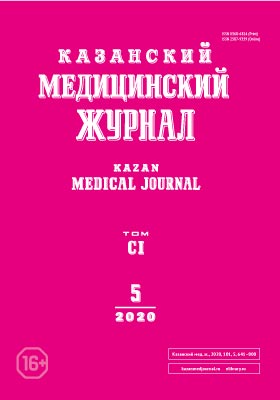Экспрессия генов Slc6a4, Tph2, Htr1b, Htr2a в спинном мозге мыши при моделировании последствий гипогравитации на Земле
- Авторы: Кузнецов М.С.1, Лисюков А.Н.1, Давлеева М.А.1, Измайлов А.А.1
-
Учреждения:
- Казанский государственный медицинский университет
- Выпуск: Том 101, № 5 (2020)
- Страницы: 698-703
- Раздел: Экспериментальная медицина
- Статья получена: 29.05.2020
- Статья одобрена: 11.09.2020
- Статья опубликована: 27.10.2020
- URL: https://kazanmedjournal.ru/kazanmedj/article/view/34243
- DOI: https://doi.org/10.17816/KMJ2020-698
- ID: 34243
Цитировать
Аннотация
Цель. Установить уровень экспрессии генов серотонинергической нейромедиаторной системы (Slc6a4, Tph2, Htr1b, Htr2a) в шейном и поясничном утолщениях спинного мозга мышей после 30-суточного моделирования последствий гипогравитации с помощью модели антиортостатического вывешивания Morey-Holton и соавт. и последующего 7-суточного периода восстановления.
Методы. Экспериментальные животные были разделены на три группы: «Вывешивание» — мыши, находившиеся в условиях опорной разгрузки задних конечностей в течение 30 сут (n=5); «Восстановление» — мыши, находившиеся в условиях опорной разгрузки в течение 30 сут, с последующей реадаптацией в течение 7 сут (n=5); «Контроль» — мыши, содержавшиеся в стандартных условиях вивария (n=5). Экспрессию генов, кодирующих синаптические белки центральной нервной системы, изучали с помощью полимеразной цепной реакции в реальном времени.
Результаты. Между исследуемыми группами животных в отношении экспрессии генов Tph2, Htr1b и Htr2a в шейном и поясничном утолщениях спинного мозга не было выявлено статистически значимых различий. При сравнении уровня экспрессии гена Slc6a4 выявлено статистически значимое повышение его уровня в 6,3 раза в поясничном отделе спинного мозга животных после моделирования последствий гипогравитации (группа «Вывешивание») с последующим снижением в 3 раза в течение периода реадаптации (группа «Восстановление»).
Вывод. Полученные нами данные о характере экспрессии гена Slc6a4, кодирующего белок-переносчик, принимающий участие в функционировании серотонинергических синапсов, могут свидетельствовать о потенциальной вовлечённости данной нейромедиаторной системы в патогенез двигательных нарушений при моделировании последствий гипогравитации на Земле.
Полный текст
Об авторах
Максим Сергеевич Кузнецов
Казанский государственный медицинский университет
Автор, ответственный за переписку.
Email: qmaxksmu@yandex.ru
Россия, Казань, Россия
Артур Николаевич Лисюков
Казанский государственный медицинский университет
Email: qmaxksmu@yandex.ru
Россия, Казань, Россия
Мария Александровна Давлеева
Казанский государственный медицинский университет
Email: qmaxksmu@yandex.ru
Россия, Казань, Россия
Андрей Александрович Измайлов
Казанский государственный медицинский университет
Email: qmaxksmu@yandex.ru
Россия, Казань, Россия
Список литературы
- Edgerton V.R., Roy R.R. Invited review: gravitational biology of the neuromotor systems: a perspective to the next era. J. Appl. Physiol. 2000; 89: 1224–1231. doi: 10.1152/jappl.2000.89.3.1224.
- Hides J., Lambrecht G., Ramdharry G. et al. Parallels between astronauts and terrestrial patients — Taking physiotherapy rehabilitation “To infinity and beyond”. Musculoskelet. Sci. Pract. 2017; 27 (1): S32–S37. doi: 10.1016/j.msksp.2016.12.008.
- Scott J.M., Warburton D.E.R., Williams D. et al. Challenges, concerns and common problems: physiological consequences of spinal cord injury and microgravity. Spinal Cord. 2011; 49: 4–16. doi: 10.1038/sc.2010.53.
- Kuznetsov M.S., Lisukov A.N., Rizvanov A.A. et al. Bioinformatic study of transcriptome changes in the mice lumbar spinal cord after the 30-day spaceflight and subsequent 7-day readaptation on Earth: New insights into molecular mechanisms of the hypogravity motor syndrome. Front. Pharmacol. 2019; 10: 747. doi: 10.3389/fphar.2019.00747.
- Лисюков А.Н., Измайлов А.А., Кузнецов М.С. и др. Нейропластичность спинного мозга мышей в условиях антиортостатического вывешивания. Авиакосм. и экол. мед. 2019; 53 (6): 94–97. doi: 10.21687/0233-528X-2019-53-6-94-97.
- Perrin F.E., Noristani H.N. Serotonergic mechanisms in spinal cord injury. Exp. Neurol. 2019; 318: 174–191. doi: 10.1016/j.expneurol.2019.05.007.
- Cope T.C. Motor neurobiology of the spinal cord. 1 ed. CRC Press. 2001; 360 р.
- Gackière F., Vinay L. Serotonergic modulation of post-synaptic inhibition and locomotor alternating pattern in the spinal cord. Front. Neural. Circuits. 2014; 8: 102. doi: 10.3389/fncir.2014.00102.
- Ghosh M., Pearse D.D. The role of the serotonergic system in locomotor recovery after spinal cord injury. Front. Neural. Circuits. 2014; 8: 151. doi: 10.1016/j.expneurol.2019.05.007.
- Bardoni R. Serotonergic modulation of nociceptive circuits in spinal cord dorsal horn. Curr. Neuropharmacol. 2019; 17: 1133–1145. doi: 10.2174/1570159X17666191001123900.
- Murphy D.L., Moya P.R. Human serotonin transporter gene (SLC6A4) variants: their contributions to understanding pharmacogenomic and other functional G×G and G×E differences in health and disease. Curr. Opin. Pharmacol. 2011; 11: 3–10. doi: 10.1016/j.coph.2011.02.008.
- Pratelli M., Pasqualetti M. Serotonergic neurotransmission manipulation for the understanding of brain development and function: Learning from Tph2 genetic models. Biochimie. 2019; 161: 3–14. doi: 10.1016/j.biochi.2018.11.016.
- Palacios J.M. Serotonin receptors in brain revisited. Brain Res. 2016; 1645: 46–49. doi: 10.1016/j.brainres.2015.12.042.
- D’Amico J.M., Li Y., Bennett D.J. et al. Reduction of spinal sensory transmission by facilitation of 5-HT1B/D receptors in noninjured and spinal cord-injured humans. J. Neurophysiol. 2013; 109: 1485–1493. doi: 10.1152/jn.00822.2012.
- Gackière F., Vinay L. Serotonergic modulation of post-synaptic inhibition and locomotor alternating pattern in the spinal cord. Front. Neural Circuits. 2014; 8: 102. doi: 10.3389/fncir.2014.00102.
- Генин А.М., Ильин Е.А., Капланский А.С. Биоэтические правила проведения исследований на человеке и животных в авиационной, космической и морской медицине. Авиакосм. и экол. мед. 2001; 35 (4): 14–20.
- Morey-Holton E.R., Globus R.K. Hindlimb unloading rodent model: technical aspects. J. Appl. Physiol. 2002; 92: 1367–1377. doi: 10.1152/japplphysiol.00969.2001.
- Andreev-Andrievskiy A., Popova A., Boyle R. et al. Mice in Bion-M 1 space mission: Training and selection. PLoS One. 2014; 9 (8): e104830. doi: 10.1371/journal.pone.0104830.
- R: A Language and Environment for Statistical Computing. Foundation for Statistical Computing. Austria, Vienna. 2017. Available online www.r-project.org (access date: 14.02.2019).
- Bos R., Sadlaoud K., Boulenguez P. et al. Activation of 5-HT2A receptors upregulates the function of the neuronal K-Cl cotransporter KCC2. Proc. Natl. Acad. Sci. USA. 2013; 2 (110 (1)): 348–353. doi: 10.1073/pnas.1213680110.
- Gerin C.G., Hill A., Hill S. et al. Serotonin release variations during recovery of motor function after a spinal cord injury in rats. Synapse. 2010; 64 (11): 855–861. doi: 10.1002/syn.20802.
- Hayashi Y., Jacob-Vadakot S., Dugan E.A. et al. 5-HT precursor loading, but not 5-HT receptor agonists, increases motor function after spinal cord contusion in adult rats. Exp. Neurol. 2010; 221 (1): 68–78. doi: 10.1016/j.expneurol.2009.10.003.
Дополнительные файлы









